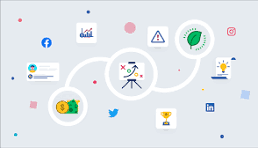The Difference Between Paid and Organic Marketing – And Why You Need Both

In the ever-evolving world of digital marketing, businesses often grapple with a critical question: Should they focus on paid marketing, organic marketing, or both? Understanding the difference between the two and how they complement each other can help you create a balanced and effective strategy. With the guidance of the best digital marketing agency, you can leverage both approaches to achieve outstanding results.
What is Paid Marketing?

Paid marketing involves promoting your business through paid advertisements on platforms like Google, Facebook, Instagram, and LinkedIn. These ads appear prominently in search results, social media feeds, or other online spaces, targeting specific audiences.
Key Features of Paid Marketing:
- Immediate Results: Paid campaigns generate quick visibility and traffic.
- Precise Targeting: You can target users based on demographics, interests, location, and behavior.
- Scalability: Adjust budgets and strategies in real-time to optimize results.
Examples include Google Ads, Facebook Ads, and influencer partnerships.
What is Organic Marketing?

Organic marketing focuses on building a long-term presence through unpaid efforts like content creation, SEO, and social media engagement. It’s about naturally attracting and retaining customers by providing valuable and relevant content.
Key Features of Organic Marketing:
- Cost-Effective: No direct ad spend, making it budget-friendly.
- Sustainable Growth: Builds trust and credibility over time.
- Broader Reach: Engages audiences through blogs, social media, and SEO.
Examples include blog posts, email newsletters, and ranking high in organic search results.
Why You Need Both

While paid and organic marketing have unique strengths, using both creates a comprehensive and impactful strategy. Here’s why:
- Immediate and Long-Term Benefits Paid marketing drives quick traffic, while organic efforts ensure sustained visibility and engagement. For instance, running a Google Ad campaign can bring instant website visitors, while a well-optimized blog continues to drive traffic for months or even years.
- Improved ROI Combining both approaches allows you to maximize your return on investment. Organic marketing reduces dependency on ads, and paid marketing fills gaps when immediate results are needed.
- Enhanced Brand Visibility Paid ads boost your brand’s reach instantly, while organic content builds a loyal audience over time. Together, they ensure consistent visibility across platforms.
- Data-Driven Insights Paid campaigns provide valuable data on audience behavior, which can inform your organic strategy. Similarly, organic marketing insights can guide ad targeting for better results.
How the Best Digital Marketing Agency Can Help
Navigating the balance between paid and organic marketing can be challenging. The best digital marketing agency can:
- Develop tailored strategies that combine both approaches.
- Optimize paid campaigns for maximum ROI.
- Enhance organic visibility through expert SEO and content marketing.
- Monitor and analyze performance to continuously improve results.
Conclusion
Paid and organic marketing are not rivals but allies in your digital marketing strategy. By understanding their strengths and leveraging both, you can create a powerful, well-rounded approach that drives traffic, engagement, and growth. Partnering with the best digital marketing agency ensures you get the expertise needed to make the most of both strategies.
Embrace the synergy of paid and organic marketing today to unlock your business’s full potential!